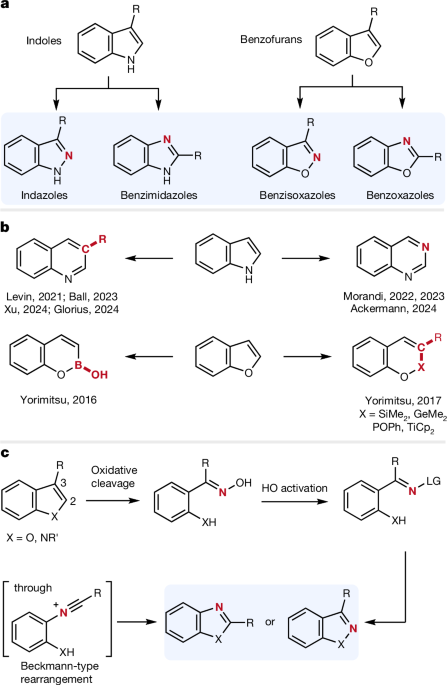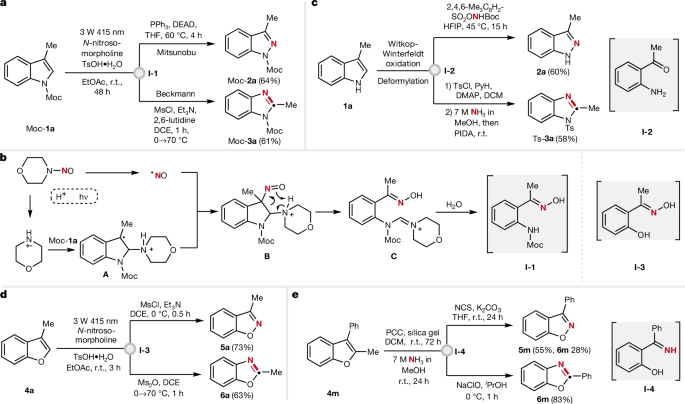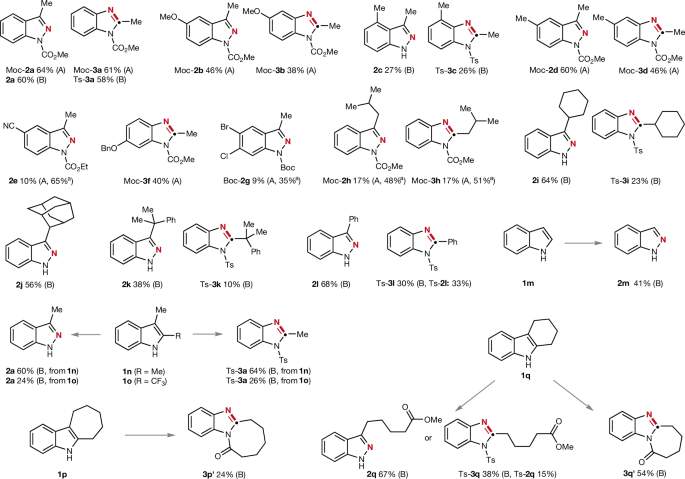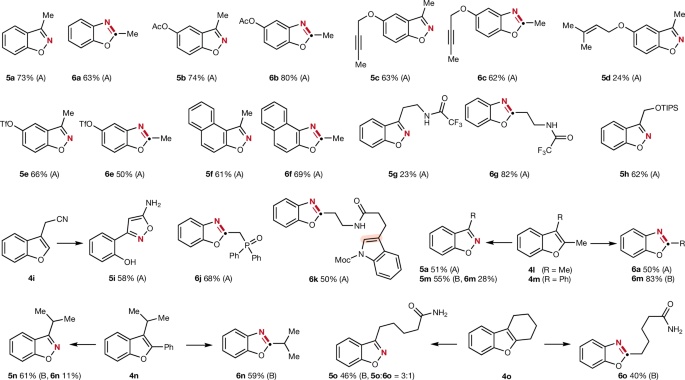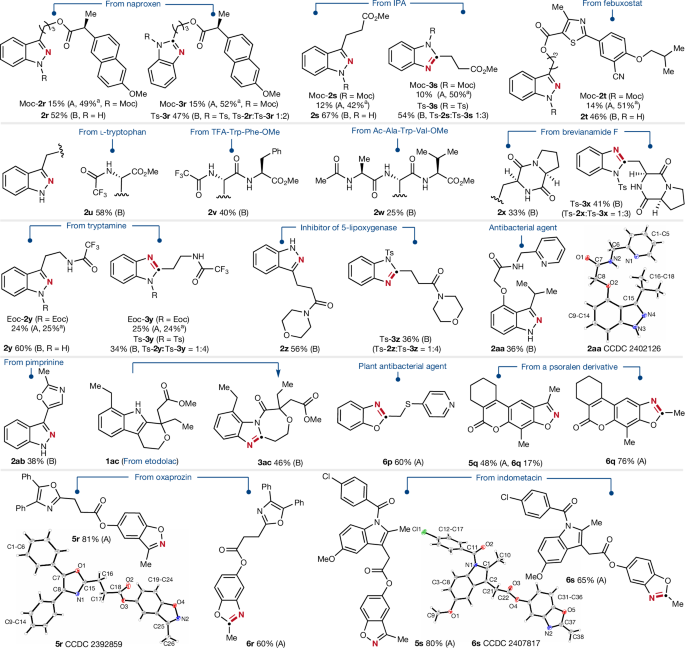Indoles are among the most important heteroarenes in chemistry, characterized by a planar bicyclic structure consisting of a benzene and a fused pyrrole ring (Fig. 1a). The indole moiety, a highly potent pharmacophore, serves as the core structure in many drugs and is also present in various natural products9,10,11. Substituting the NH group in indoles with an oxygen atom yields benzofurans, another significant class of heteroarenes. As oxygen analogues of indoles, benzofurans show valuable biological activities and are commonly found as substructures in natural products and pharmaceuticals12,13.
a, Transformation of indoles to indazoles and benzimidazoles requires C to N atom swapping and also skeletal reorganization for the latter process. Analogous transformations on benzofurans deliver benzisoxazoles and benzoxazoles. b, State of the art in skeletal editing of indoles and benzofurans. These known processes all proceed through atom insertion resulting in ring enlargement. c, Design of a reaction sequence for the editing of indoles and benzofurans without changing the ring size. These structural reorganizations comprise oxidative cleavage of the heteroarene entity, OH-activation followed by Beckmann-type rearrangement or substitution at nitrogen. LG, leaving group.
Skeletal editing of heteroarenes has recently emerged as a highly valuable tool for altering the core structure of these molecules at a late stage1,2. Instead of constructing a heteroarene from basic building blocks, skeletal editing enables diversification of an existing complex pharmacophore, thereby enhancing the efficiency of drug development14,15,16,17,18,19,20. Essentially, the synthesis begins with the final product. Skeletal editing can be achieved through atom swapping, atom insertion, atom deletion or reorganization of the compound’s backbone structure. For example, the Vasil’ev and Park groups disclosed oxygen-to-nitrogen transmutations of isoxazoles to pyrazoles and furans to pyrroles, respectively21,22. Herein we report C to N atom swaps in indoles and benzofurans to give indazoles23,24 and benzisoxazoles5. Both these bicyclic heteroarenes show interesting and highly valuable biological activities. Moreover, by using a slightly varied chemical strategy, benzimidazoles25 and benzoxazoles8 are equally well accessible starting from the same intermediates. These latter two important compound classes are formed through C to N atom swapping with concomitant skeletal reorganization. During the preparation of this manuscript, Morandi and coworkers reported a similar C to N swap approach of indoles to benzimidazoles through sequential oxidation with subsequent Beckmann rearrangement26. This strategy operates orthogonal to ours while selectively transforming 2,3-unsubstituted indoles. However, indole-to-indazole conversion as well as the skeletal editing of benzofurans was not reported by the authors.
Skeletal editing of indoles has recently garnered significant interests. The research groups of Levin27, Ball28, Xu29 and Glorius30 have achieved elegant carbon insertion, leading to the formation of quinolines (Fig. 1b). N insertion into indoles, as demonstrated by Morandi31,32 and Ackermann33, provides direct access to quinazolines. In the context of skeletal editing of benzofurans, Yorimitsu successfully accomplished the insertion of boron, silicon, germanium, phosphorous and titanium into the C2–O bond34,35. However, skeletal editing of indoles and benzofurans to give all four classes of title compounds is currently unknown and certainly highly desirable.
Our general design strategy for the structural reorganization of both indoles and benzofurans is presented in Fig. 1c. On oxidative cleavage of the C2=C3 double bond in these heteroarenes, oximes should be accessible. Transformation of the OH group of the oxime functionality into a leaving group will afford reactive intermediates that are poised to engage in a Beckmann rearrangement to give nitrilium cations. Intramolecular trapping of such cations by the N respective O atom of the former indole or benzofuran core should directly afford the corresponding benzimidazoles and benzoxazoles, respectively36,37. On the other hand, the activated oxime ether functionality might also act as an N electrophile to directly provide indazoles or benzisoxazoles through N or O addition onto the oxime nitrogen atom38,39.
Studies were commenced by investigating the ring cleavable radical oximation of the N-protected indole Moc-1a to give I-1. N-nitrosamines are known to engage in light-mediated N–N bond homolysis to give the persistent NO radical along with an aminyl radical. Under acidic conditions, the latter gets protonated to a more reactive aminyl radical cation, which efficiently adds to alkenes and the adduct transient C radicals can then be trapped by the persistent NO to give the corresponding β-amino alkyl nitroso compounds40. We tested this transformation on indole Moc-1a using N-nitrosomorpholine as the aminyl radical precursor. Reaction is best conducted in ethyl acetate by irradiation with a blue light-emitting diode (415 nm, 3 W) in the presence of toluene sulfonic acid for 48 h at room temperature to give I-1 in high yield (78%) (Fig. 2a). We propose that the aminyl radical cation generated through light-mediated N–N bond homolysis and protonation reacts at the C2 position of Moc-1a to give the distonic benzylic radical cation A that is selectively trapped by the persistent NO (ref. 41) to give the nitroso adduct B (Fig. 2b). This nitroso compound B is suggested to engage in a C–C bond cleavage with concomitant proton transfer to give oxime C (ref. 42). Hydrolysis eventually leads to the intermediate I-1.
a, Radical 1,2-aminonitrosylation of a 3-substituted indole to give a ring-opened oxime that can further react to an indazole or a benzimidazole, respectively. b, Proposed mechanism for the radical oxidative ring-opening of the heteroarene entity in an indole. c, Alternatively, oxidative ring cleavage of the indole heteroarene core can also be achieved through Witkop–Winterfeldt oxidation and subsequent deformylation to give the corresponding o-aminoaryl ketone that is further converted to an indazole or to a ketimine giving a benzimidazole. d, Analogous chemical transformations on benzofurans. e, Alternative protocol for transforming benzofurans to benzisoxazoles and benzoxazoles. Moc, methoxycarbonyl; Ts, tosyl; HFIP, hexafluoroisopropanol; MsCl, methanesulfonyl chloride; Ms2O, methanesulfonic anhydride; PIDA, (diacetoxyiodo)benzene; NCS, N-chlorosuccinimide; r.t., room temperature; PCC, pyridinium chlorochromate; DCM, dichloromethane; DCE, dichloroethane; DMAP, 4-dimethylaminopyridine; DEAD, diethyl azodicarboxylate; THF, tetrahydrofuran.
With the optimized protocol for mild radical cleavage of the indole core in hand, we next focused on the diversification towards construction of indazoles and benzimidazoles. Under Mitsunobu conditions38 the N-protected indazole Moc-2a was obtained in 64% overall yield. On the other hand, O-mesylation of the oxime I-1 with methanesulfonyl chloride followed by heating gave the benzimidazole Moc-3a through a Beckmann-type rearrangement in 61% overall yield36. We noted that N protection of the indole is required for successful oxidative radical cleavage of the indole core. Therefore, an alternative protocol was developed that is also working on free NH indoles. Oxidative cleavage of the C2=C3 double bond by means of Witkop–Winterfeldt oxidation43,44 and subsequent deformylation led to the corresponding ortho-acyl aniline I-2, which on treatment with Me3C6H2SO2ONHBoc directly afforded the free indazole 2a in good overall yield (Fig. 2c)39. Transformation of ortho-acyl aniline to a benzimidazole can be realized on N-protected anilines. Thus, Witkop–Winterfeldt oxidation on indole 1a, N protection with 4-toluenesulfonyl chloride, o-aminoaryl ketimine formation with ammonia and PhI(OAc)2 mediated Beckmann-type rearrangement provided the N-protected benzimidazole Ts-3a (58%)37. We were pleased to find that oxidative radical cleavage with N-nitrosamines is also applicable to benzofurans, thereby significantly expanding our strategy, as documented by the successful skeletal editing of benzofuran 4a to give benzisoxazole 5a through C to N atom swapping (73%) (Fig. 2d). As for the indole series, the oxime intermediate I-3 also acts as a common editing platform for the benzofurans and accordingly I-3 can be readily diverted to also access the corresponding benzoxazole 6a (63%). Alternatively, a complementary ionic oxidative cleavage of the benzofuran ring is also provided. The C2=C3 double bond of benzofuran 4m is cleaved on treatment with pyridinium chlorochromate (PCC) and subsequent aminolysis gives the respective o-hydroxyaryl ketimine I-4. Chlorination of the imine with N-chlorosuccinimide under basic conditions or with aqueous NaOCl smoothly forms benzisoxazole 5m (55%) or the corresponding benzoxazole 6m (83%), respectively45.
The scope of these different transformations was investigated on various indoles and benzofurans using either the radical-mediated approach (method A) or an ionic oxidative cleavage of the heteroarene core with different oxidants (method B). In selected cases both methods were tested (Figs. 3 and 4). Electron-donating substituents such as methoxy, methyl or benzyloxy at the 5- or 6-position of the indole entity in 3-methyl substituted systems were tolerated and as examples the indazoles Moc-2b and Moc-2d were obtained in 46–60% yield using the radical approach. The corresponding benzimidazoles Moc-3b and Moc-3d as well as Moc-3f were equally well accessible. Steric effects are of importance, as the 4-methyl indole 1c gave the edited indazole 2c and benzimidazole Ts-3c in lower yields. We found that an electronic withdrawing group (cyano or halo-substituents) at the indole core significantly reduced reactivity for the radical cleavage, and the targeted indazoles were obtained in low yields along with unreacted starting indoles (2e and Boc-2g). The size of the 3-alkyl substituent on the indole also affects reactivity. Whereas indoles bearing secondary or tertiary carbon substituents in the 3-position (cyclohexyl 1i, 2-adamantyl 1j or cumyl 1k) were smoothly converted to indazoles 2i–2k in 38–64% yield, the corresponding imidazoles were formed with lower efficiency (Ts-3i and Ts-3k). Compared to those congeners, the sec-butyl indole reacted less efficiently through the radical pathway. Yet, the targeted indazole Moc-2h and benzimidazole Moc-3h could be readily isolated and unreacted starting Moc-indole 1h was recovered in both cases. We were pleased to find that 3-aryl-substituted indoles also engaged in these skeletal editing processes, as documented for the phenyl derivative 1l. The indazole 2l was obtained in 68% yield, whereas Ts-3l was isolated in 30%. In the latter case, indazole or benzimidazole selectivity for the final heteroarene ring reconstruction was not perfect and we obtained the N-tosylated indazole Ts-2l as the byproduct (33%), showing that the selective reorganization is not that trivial. The parent unsubstituted indole was successfully converted to indazole 2m (41%). For the 2,3-disubstituted indoles 1n and 1o we successfully achieved the CMe and CCF3 to N swap showing that this structural editing is not restricted to 2-unsubstituted indoles. The indazole 2a and the benzimidazole Ts-3a were both formed in good yields from parent 1n. However, the trifluoromethyl congener 1o afforded the respective products 2a and Ts-3a in lower yield (24–26%) due to the electron-withdrawing effect of the CF3 group lowering reactivity for the initial oxidative cleavage46. To further showcase the use of our strategy, challenging 2,3-disubstituted indoles bearing six- or seven-membered fused rings (1q and 1p) were also examined inspired by the prevalence of polycyclic indole scaffolds in nature. Six-membered ring annellated derivative 1q could be transformed through Witkop–Winterfeldt oxidation and subsequent Schmidt-type rearrangement to benzimidazole 3q’ bearing an enlarged seven-membered ring in good yield (54%). However, the seven-membered ring congener 1p reacted with lower efficiency to 3p’ (24%), probably due to inherent eight-membered ring strain that was built up during structural reorganization. Notably, 1q can also be transformed to indazole 2q and benzimidazole Ts-3q carrying ring-opened linear chain substituents.
All reactions were conducted under the optimized conditions specified in Fig. 2. For further details we refer to the Supplementary Information. Yields provided correspond to isolated overall yields starting from the corresponding indole. Method A corresponds to the radical-induced heteroarene ring cleavage with N-nitrosomorpholine, and method B uses different chemical oxidants to cleave the indole ring. aYield of the recovered starting material.
All reactions were conducted under the optimized conditions specified in Fig. 2. For further details we refer to the Supplementary Information. Yields provided correspond to isolated overall yields starting from the corresponding benzofuran. Method A corresponds to the radical-induced heteroarene ring cleavage with N-nitrosomorpholine, and method B uses PCC to oxidatively cleave the benzofuran ring. TIPS, triisopropylsilyl.
We next addressed the editing of benzofurans and noted generally higher efficiency in the radical-mediated oxidative cleavage process compared to the indoles (Fig. 4). The reaction of the 5-acetoxy-substituted 3-methylbenzofuran (4b) provided benzisoxazole 5b in high yield (74%) and the corresponding reorganized benzoxazole 6b was isolated in 80% yield. The 5-propargyloxy-substituted benzofuran reacted equally well to give 5c and 6c in good yields. It is important to note that the triple bond in 4c is tolerated under the radical conditions. Further, prenyloxy-benzofurans are also eligible substrates as shown by the successful preparation of 5d, albeit a lower yield was achieved. A trifluorosulfonyloxy substituent is compatible with our two processes and the targeted 5e and 6e were obtained in good yields. We could also show that the benzannellated benzofuran 4f was readily converted to its edited benzisoxazole 5f and benzoxazole 6f. Benzofurans featuring different substitution patterns on the 3-position as well as 2,3-disubstitued benzofurans were also evaluated. The trifluoroacetamide substituted benzofuran 4g could be transformed into the corresponding benzoxazole 6g in excellent yield (82%). However, the benzisoxazole 5g was obtained in diminished yield (23%) caused by unproductive N–N interactions between the side chain amide and the oxime moiety during the ring closure step under the basic conditions. Silyl ether and phosphine oxide were compatible under the reaction conditions affording benzisoxazole 5h and benzoxazole 6j in good yields (62–68%).
When a cyanomethyl group was installed at the 3-position, the oxime group intermediately formed in the radical-mediated oxidative cleavage of benzofuran 4i subsequently attacked as a nucleophile the cyano moiety to eventually give the isoxazole 5i (58%). To compare the relative efficiency of the radical-induced oxidative cleavage between indoles and benzofurans, substrate 4k bearing both of these heteroarene cores was transformed, showcasing larger reactivity for the benzofuran moiety, which was efficiently edited to the benzoxazole 6k (50%) with the indole core remaining unreacted. CMe to N swap in 2,3-dimethylbenzofuran 4l was successfully realized to give 5a and 6a through the radical pathway. Moreover, the sterically more demanding disubstituted benzofurans 4m and 4n also engaged in CMe or CPh to N swap using PCC for initial oxidative cleavage. Benzofuran 4o carrying a six-membered fused ring was successfully converted to the open-chain benzisoxazole 5o (46%) and benzoxazole 6o (40%).
Finally, we tested our methods on a wide range of more complex compounds (Fig. 5). The naproxen-indole conjugate Moc-1r was successfully transformed to the indazole Moc-2r (15%) and its isomeric benzimidazole Moc-3r (15%) under the radical conditions, whereas unreacted starting material could be recovered in a roughly 50% yield. Similar outcomes were obtained for indole Moc-1s and Moc-1t that were prepared from indole-3-propionic acid and febuxostat. Using the alternative oxidant-mediated protocol (method B) significantly improved yields were obtained for the overall sequences. Thus, the indoles 1r–1t were successfully edited to provide the indazoles 2r–2t in 46–67% yield and the corresponding benzimidazoles Ts-3r and Ts-3s were obtained in 47–54% yield. Furthermore, the developed strategies were also applicable to the late-stage diversification of bioactive compounds and drug-derived structures. Protected tryptophan 1u gave the corresponding indazole product 2u in good yield (58%). Likewise, tryptophan-containing dipeptide 1v and tripeptide 1w were converted smoothly to indazoles 2v and 2w. Brevianamide F (1x), which shows diverse biological activities and acts as important starting material for different fumitremorgin class alkaloids47, was structurally reorganized to afford the corresponding indazole 2x and benzimidazole Ts-3x. Tryptamines are found in the human brain as important neurotransmitters and represent core structures of many drugs48, so we tested the skeletal editing on derivative 1y to afford indazoles Eoc-2y and 2y, as well as the benzimidazoles Eoc-3y and Ts-3y under both radical and the chemical oxidant-induced ring-cleavage conditions (Eoc, ethoxycarbonyl). Better yields for this substrate were obtained through the ionic pathway (method A Eoc-2y (24%) versus method B 2y (60%); method A Eoc-3y (25%) versus Ts-3y (34%)). Similarly, indole 1z, which is a potent 5-lipoxygenase inhibitor49, was successfully converted to indazole 2z (56%) as well as benzimidazole Ts-3z (36%), further expanding the functional group tolerance towards amides. Noteworthy, the antibacterial agent50 1aa bearing both a tethered pyridine core and a sterically demanding isopropyl substituent at the C3-position was successfully transformed to the indazole 2aa documenting the tolerance towards pyridines. The structure of 2aa was unambiguously assigned by X-ray crystal structure analysis. Pimprinine, an alkaloid originally isolated from Streptomyces showing a variety of biological activities51, afforded the corresponding atom swapped indazole product 2ab (38%), leaving the oxazole heterocycle untouched. Moreover, the etodolac-derived substrate 1ac was transformed to the desired seven-membered ring-fused benzimidazole product 3ac (46%), underlining the potential of the protocol for late-stage modification of drugs.
Skeletal editing of indoles and benzofurans with tethered bioactive moieties and pharmaceutical compounds. Method A corresponds to the radical-induced heteroarene ring cleavage with N-nitrosomorpholine, and method B uses ionic oxidants to cleave the heterocycle rings. For further details, refer to the Supplementary Information. aYield of the recovered starting material. IPA, indole-3-propionic acid.
Along with bioactive indoles we also tested the skeletal editing of bioactive and drug-conjugated benzofurans using the radical approach. The benzofuran 4p tethering a thioether-bridged pyridine core at the C3 positon, showing antibacterial activities in plants52, was successfully edited to benzoxazole 6p in 60% yield. Furthermore, the skeleton of substrate 4q, a new derivative of the photochemotherapeutic agents methoxsalen and trioxsalen53, gave the corresponding benzisoxazole 5q (48%) and benzoxazole 6q (76%) using a one-pot process that will be further described below. The benzofuran 4r derived from oxaprozin was readily transformed to the benzisoxazole 5r in excellent 81% yield. Applying the diverting reaction path, benzoxazole 6r was obtained in 60% yield. Notably, the oxazole moiety in 4r remained unreacted. We also tested a complex system derived from indomethacin bearing both an indole and a benzofuran moiety (4s). As expected, the sterically less hindered benzofuran entity reacted chemo-selectively to give benzisoxazole 5s in 80% yield. Starting with the same substrate 4s, benzoxazole 6s was obtained in a good yield (65%). The structures of 5r and 6s were unambiguously assigned by X-ray crystal structure analysis.
The above-discussed diversified skeletal editing of indoles and benzofurans is highly efficient to quickly access up to four different classes of products through common intermediates. However, when no diversification and only one product is demanded efficient one-pot manipulations are often desired. Therefore, we showcased that our strategy can be also efficiently performed in one-pot. This was demonstrated with benzofuran 4s as the starting material using an in situ formed N-nitrosomorpholine solution (Extended Data Fig. 1a). The corresponding benzisoxazole 5s was obtained in 72% and the benzoxazole 6s in 55% overall yield, the latter on a 3.0-mmol scale. Noteworthy, as N-nitrosomorpholine shows toxicity, its in situ formation and direct use is risk lowering. Finally, we could show that skeletal editing with concomitant 15N-labelling is possible through the herein introduced approach. Selectively 15N-labelled N-nitrosomorpholine was readily prepared from commercially available Na15NO2 (Extended Data Fig. 1b and Supplementary Information). With this labelled nitroso amine in hand, Moc-1a was successfully converted to Moc-15N-2a that was isolated in 60% yield with more than 95% 15N-incorporation. CH to 15N swap was also achieved on the indole Moc-1ad to afford the indazole Moc-15N-2ad in 26% yield along with 39% unreacted indole. The lower yield is due to the presence of the electron-withdrawing ester group at the indole ring. Of note, Moc-15N-2ad is a building block to access labelled orally bioavailable small-molecule inhibitors of CDK8 for the treatment of cancer or for the synthesis of sodium channel inhibitors54,55.


